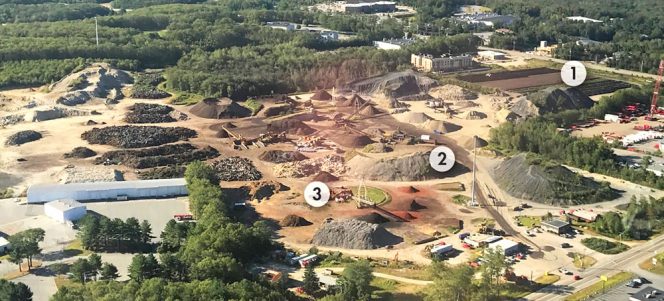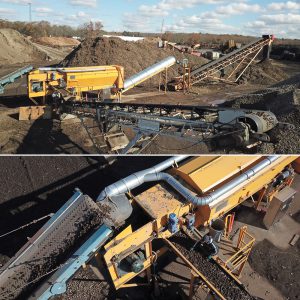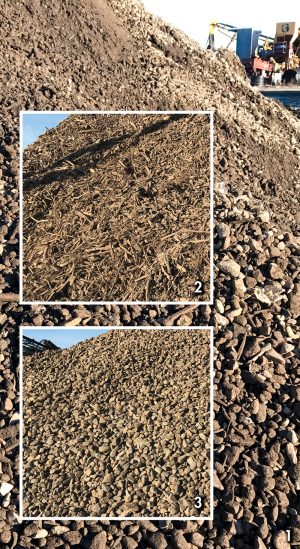Smithfield Peat acquired a newly designed air separator to help process 100,000 cubic yards of mixed stone, wood and loam tailings into marketable products.
Joe Gallagher
BioCycle January 2018

The Smithfield Peat Co. 81-acre facility includes yard trimmings composting (1), tailings separation and cleaning (2), and mulch production and colorizing (3). Photo by Jackson Despres
In 1995, with its supply of peat nearly depleted, and the Rhode Island Department of Environmental Management (RIDEM) about to adopt composting regulations, Smithfield Peat “officially” entered the composting business with the intent of amending its screened loam with compost. The company had been composting “by default,” as it always recycled leaves, grass, brush, and stumps from its own projects, and had been accepting a high volume of inbound material from landscape customers who were able to bring in yard trimmings free of charge for many years. To assist with expansion into composting, it sought a bank loan to purchase a stationary grinding system.

Tailings comprised of loam, wood and stone are preprocessed via a vibrating screen, hand picking of oversized wood and then a trommel to separate out the loam. The wood and stone are then separated using an AirMax Material Density Separator (bottom photo). Photos courtesy of CBI
Smithfield Peat’s compost production process includes multiple grinds of organic material formed into windrows. The windrow temperatures are carefully monitored and turned as needed to kill off weed seeds. Finished compost is finely screened to one-quarter-inch, providing a nutrient rich product highly regarded by homeowners, landscape professionals, nurseries, and organic farmers.
Smithfield Peat also invested in equipment to manufacture mulch products. “In the early 1970s, we initially bought mulch wholesale and retailed it here in the yard,” Despres explains. “With the primary grinder in place, the installation of a secondary CBI grinder, coloring machine, and extensive use of conveyors, the company could produce mulch in one pass. This gave us access to yet another market by eliminating the mulch wholesaler. Sheared stumps are fed into a disc screen to remove fines, into a primary grinder, and then down to the final size through a secondary grinder and directly into a coloring machine.” Logs and whole tree chips are loaded into a hopper between the primary and secondary grinders when the prescreener isn’t needed.
Tackling The Tailings
Smithfield Peat Co purchased a jaw and cone crusher in 1996, enabling the company to expand into the aggregates business with crushed stone, processed gravel, and reprocessed asphalt and concrete. These products are recycled into reclaimed road base materials. With production of compost, mulch, topsoil and aggregates, Smithfield Peat evolved into a one-stop shop. This success, however, created one huge problem.
Despite this, he saw a latent opportunity in the pile, so he continued to seek a solution. “I examined existing technologies available in the marketplace and challenged multiple manufacturers to come up with a machine that would effectively separate rock and wood,” Despres notes. Leveraging his relationship with CBI, Despres’ vision ultimately led to the release of CBI’s AirMax Material Density Separator, which is effective for separating rock from wood and plastic, mulch cleanup, compost cleanup, C&D recycling, glass recycling, and a variety of other applications. It performs similarly to a standard air knife, and is equipped with four electric motors (total of 42 horsepower) to separate materials of different densities. Lighter material is blown off the stone and through the expansion chamber, while the heavier stone falls below to a conveyor belt. Seventy percent of the air is recirculated through the system.
At Smithfield Peat, the tailings comprised of loam, wood and stone are preprocessed prior to going into the AirMax. They first go through a vibratory screen. Larger material is sent to a picking station where laborers manually pick the oversized wood; the stone drops off the end of the conveyor. From there, undersized material passes through a trommel screen that separates the loam out. The trommel screen discharges a wood and stone mix into the AirMax.
It separates the wood and stone into two components so that everything is usable in the stream,” Despres explains. “The stone is exceptionally clean and we’re able to send that to the crushing operation to make dimensional stone out of it. The wood is either ground for compost or mulch production. In essence, all of the 100,000 yards of waste material will be turned into finished, valuable product. It’s extremely important that we do that from both a business and an environmental standpoint.”
Joe Gallagher is the Marketing Coordinator for Terex CBI Ecotec.











